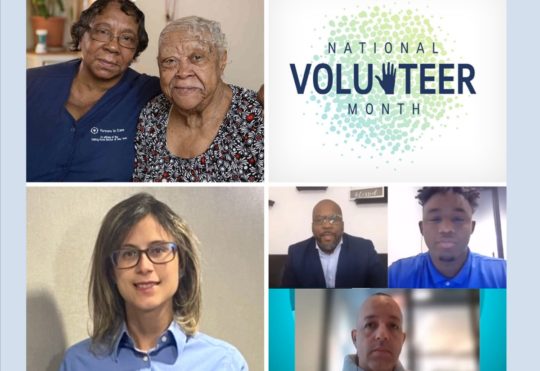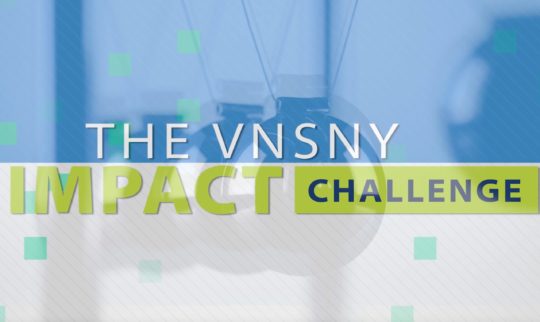Remembering 9/11
The following article is dedicated to the memory of those who died in the attacks of September 11, 2001, and to those who served in a rescue and recovery capacity that day and in the weeks afterward. You can also click here to read the special issue of Frontline published immediately after 9/11, which describes how our own staff responded to the tragedy.
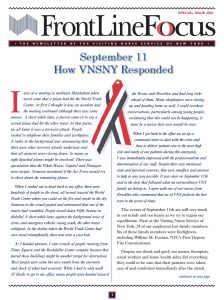 It was 17 years ago that the 9/11 terrorist attacks killed 3,000 people in New York City, along with hundreds of other victims in Washington DC and on the four planes commandeered for the attack. “Although it’s been a while now, it’s important that we never forget what happened that day,” says Frank Passarella, VNSNY’s Director of Safety and Security, who was a 9/11 first responder. Two weeks ago, he and his wife, Sonia Cuevas, both sat before a video camera in downtown Manhattan to record the stories of what they experienced that day. “It was very hard emotionally to relive what happened, which is why we hadn’t done it earlier,” says Frank. “We’re actually unique, because Sonia works at the New York City Chief Medical Examiner’s office, making us the only husband-wife team of 9/11 responders.” Their recordings are now a permanent part of the video archive at the 9/11 Tribute Museum on Greenwich Street in Lower Manhattan, where they can be accessed on touchscreens by visitors to the museum. “I want to encourage everyone to visit the museum when they have a chance!” adds Frank.
It was 17 years ago that the 9/11 terrorist attacks killed 3,000 people in New York City, along with hundreds of other victims in Washington DC and on the four planes commandeered for the attack. “Although it’s been a while now, it’s important that we never forget what happened that day,” says Frank Passarella, VNSNY’s Director of Safety and Security, who was a 9/11 first responder. Two weeks ago, he and his wife, Sonia Cuevas, both sat before a video camera in downtown Manhattan to record the stories of what they experienced that day. “It was very hard emotionally to relive what happened, which is why we hadn’t done it earlier,” says Frank. “We’re actually unique, because Sonia works at the New York City Chief Medical Examiner’s office, making us the only husband-wife team of 9/11 responders.” Their recordings are now a permanent part of the video archive at the 9/11 Tribute Museum on Greenwich Street in Lower Manhattan, where they can be accessed on touchscreens by visitors to the museum. “I want to encourage everyone to visit the museum when they have a chance!” adds Frank.
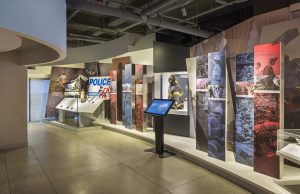
9-11 Tribute Museum, 92 Greenwich St. NYC
So that VNSNY staff could hear his story directly, Frank also agreed to share his 9/11 story with Frontline VNSNY. Following is his personal account of that experience:
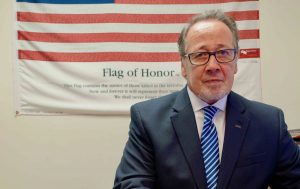 “Is This Heaven? Or Are We Okay?” Frank Passarella Recalls 9/11
“Is This Heaven? Or Are We Okay?” Frank Passarella Recalls 9/11
On the morning of September 11, 2001, I was on my way to work with my wife, Sonia, in our car, driving on the Long Island Expressway. We lived in Queens, and I was working in a special undercover unit at the time, a joint task force between the NYPD and the federal government. My wife, who is a forensic toxicologist, worked at the Chief Medical Examiner’s office on First Avenue. I had my police radio with me, but I hadn’t turned it on. As we drove down the LIE, the World Trade Center was right in front of us and we saw smoke coming out of Tower Two. I turned my radio on, and there was a lot of talk about a plane hitting the tower. I said to my wife, “I wonder if some small plane hit it by accident, like the Empire State Building back in the 1940s?” Then, as we were watching, we saw the second airliner make that infamous U-turn and go into Tower One. I said, “Oh my God, we’re under attack!” With that, I turned on my red light and siren and we red-lighted it into Manhattan. I dropped my wife off near her office on Second Avenue, and kissed her goodbye. She said later that she knew where I was going by the look in my eyes.
Our task force worked out of a covert office on Hudson Street. I parked my car there and picked up my bulletproof vest and my police raid jacket. The office wasn’t far from the World Trade Center, so I began walking down there with Jason, another member of the task force. As we got closer, we could see everything that was going on, including the people who were jumping from the buildings because of the fire. I can still see those people’s faces to this day.
This was so early in the attacks that there wasn’t any command center set up, so everything was haphazard. Usually with any event like this, there’s a command center where you can go over and say, “What do you want me to do?” But that hadn’t happened yet. It was all hands on deck—whatever it was you had to do, you did.
Just as we arrived at the towers, we heard on the police radio that the Pentagon had been attacked. My colleague and I said to each other, “We’re at war.” That’s the first thing that came into our heads. We went over to Tower Two and started telling people which way to go in order to be safe. Then the building started to come down. We weren’t that close to the tower—we were in one of the courtyards. This big plume of smoke came up all around, and we heard yelling and screaming, “Help me! Help me!” We couldn’t see a thing. So Jason and I went into the smoke, feeling around with our hands and telling people to follow our voices. People were grabbing our hands and we would pull them in a safe direction. Some weren’t able to walk, and we had to actually carry them out. One guy was in very bad shape, so we flagged down an ambulance and put him in there.
We were on the other side of the Trade Center now, and couldn’t get back to where we had been, so we began walking towards Tower One. On the way, I remember a guy from the terrorist task force throwing wet towels at us that he had soaked in a bucket of water, so we could wipe the debris off our faces and hands. We didn’t know it at the time, but the government had sent fighter jets to the area, and as we were walking we suddenly heard them right overhead. We thought we are under attack again. A fireman yelled to hit the deck, and we all did. We realized then they were government planes, so we felt a little better.
We kept walking toward Tower One, directing people where to go. And then one of the firemen we were with yelled out “It’s coming down!” This time we were pretty close to the building, so we started to run. I saw a police truck in front of me, parked on the street, so I figured maybe that would be a safe place to take shelter, and that maybe I could even get it started and drive it away. There was a guy who had fallen on the ground in front of me who I had helped a few minutes before—he was looking for his girlfriend who was in one of the buildings. So I picked him up, opened the door of the truck and threw him inside. There was another guy already in the truck, behind the driver’s seat, who was just sitting there in shock. As I jumped in, debris was coming down hard all around us, so I quickly closed the door. The blue sky was gone, and we were surrounded by a brown, dark, ugly cloud. If we hadn’t been inside that truck, all of us might have been killed then and there.
As the debris came raining down, I heard a banging sound—someone was pounding on the window of the truck. Looking out, I saw the silhouette of a fireman. I opened the door and he jumped in across our bodies, but the debris was coming down so hard that I couldn’t close the door again. Eventually I did manage to close the door, but by that time we were buried up to our noses in debris inside the truck. Everything was pitch black, and none of us could move. Truthfully, I thought it was all over for us. I still had my radio in my hand but I couldn’t bring it to my mouth to speak into it, so I started to tap out an SOS with my fingers, hoping someone would pick up the signal.
I can’t tell you to this day how long we were in the truck. Probably, it was close to an hour. Finally, I saw a little blue light in the corner of the truck, and I asked myself, “Is this heaven? Or are we okay?” A couple of minutes after that, the doors opened and a group of firemen and police officers pulled us out of the truck and lay us down and threw water on us to clean us off. A little while after that, I got up and went back to the site to try and help out again. I was hurt, but I didn’t know it, and when I got to Ground Zero I just collapsed. They had to pick me up in an ambulance and take me to St. Vincent’s Hospital. I was treated there but I didn’t want to stay the night. Someone from my command came and picked me up and drove me to my wife’s office to pick her up. When my wife first saw me, she said she couldn’t even recognize me. I looked like a totally different person.
The next day, being who I am, I actually went back to work. Meanwhile, my wife was working the four-to-midnight shift at the Chief Medical Examiner’s office. For the next two weeks, I would come home from my day job, drop her off at work, and then go back to do recovery work at Ground Zero in the evenings. For Sonia, the aftermath lasted even longer. She spent nine months working to help identify hundreds of bodies of the 9/11 victims, which as a forensic toxicologist wasn’t something she was used to doing.
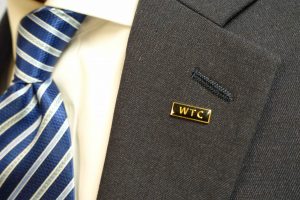 The experience changed both of our lives. It’s why we no longer live in New York City. I retired a year and a half after 9/11, and we moved out to Pennsylvania, just to get out of the city and rest our heads. I also developed sarcoidosis and asthma from working at Ground Zero, and had to have an implantable cardioverter-defibrillator put in. I think the hardest thing, though, has been survivor’s guilt. So many innocent people died that day, and I can’t help thinking, “I was buried in a truck. Why am I not dead also?” So that I’ll always remember those innocent lives lost, I keep what they call the Flag of Honor in my office and in my home. It’s an American flag with the names of every 9/11 victim written into it.
The experience changed both of our lives. It’s why we no longer live in New York City. I retired a year and a half after 9/11, and we moved out to Pennsylvania, just to get out of the city and rest our heads. I also developed sarcoidosis and asthma from working at Ground Zero, and had to have an implantable cardioverter-defibrillator put in. I think the hardest thing, though, has been survivor’s guilt. So many innocent people died that day, and I can’t help thinking, “I was buried in a truck. Why am I not dead also?” So that I’ll always remember those innocent lives lost, I keep what they call the Flag of Honor in my office and in my home. It’s an American flag with the names of every 9/11 victim written into it.
In 2004, about a year after I retired from law enforcement, I came to work at VNSNY as the manager of employee safety. I love this job, and the reason goes back to all the nurses at St. Vincent’s Hospital who treated me on the day of 9/11. They took such incredible care of me that day that it brings tears to my eyes now, thinking about it. I wanted to give something back to them. One of the things the nurses kept saying to me at St. Vincent’s that really stayed with me was, “Don’t worry, baby—everything will be okay.” Now, in my safety classes, sometimes I’ll share my story of how those nurses cared for me on 9/11. Then I tell the VNSNY staff I’m working with, “I’m going to say the same thing to you: If you follow all the safety instructions that you’re learning here, then don’t worry, baby—everything will be okay.”
